Exploring the great outdoors can be a thrilling adventure, but it also exposes you to the risk of injuries and emergencies. When you’re far away from medical facilities and emergency services, knowing how to provide first aid is essential to ensuring your safety and that of your companions. In this section, we will introduce you to the importance of wilderness first aid for injuries and the necessary techniques and certifications needed to provide emergency medical care in remote outdoor environments.
Key Takeaways
- Wilderness first aid for injuries is crucial for anyone venturing into the outdoors.
- Acquiring the necessary training and knowledge can help you confidently handle emergencies and ensure your safety in remote environments.
- Essential techniques and certifications are required to provide emergency medical care in the wilderness.
- Knowing how to assess and stabilize patients until professional medical help arrives is crucial.
- A well-stocked and properly maintained wilderness first aid kit can make all the difference in an emergency.
Understanding Wilderness First Aid Training
When it comes to wilderness first aid for injuries, having the proper training is crucial. Learning wilderness first aid techniques can mean the difference between life and death in remote areas where medical assistance can be far away.
Wilderness first aid training covers various topics such as identifying and treating injuries, managing environmental hazards, and remote communication and evacuation. Through this training, you’ll gain essential skills and knowledge to handle emergencies in the wilderness.
Disclosure: When you buy through links on our site, we may earn an affiliate commission.
One of the most critical aspects of wilderness first aid is having a well-stocked first aid kit. A wilderness first aid kit should contain items specific to the types of injuries and emergencies you may encounter while in the outdoors. Some essential items to include in your kit are:
| Item | Purpose |
|---|---|
| Bandages and gauze | To dress cuts and wounds |
| Tweezers | To remove splinters or debris from wounds |
| Trauma shears | To cut clothing or gear in emergency situations |
| Antibacterial ointment | To prevent infection of wounds |
| Tourniquet | To control life-threatening bleeding |
During your wilderness first aid training, you’ll also learn how to handle common injuries such as sprains and fractures, hypothermia, heatstroke, and animal bites. You’ll explore techniques to assess and stabilize patients until they can receive proper medical treatment, which may involve evacuating them from the wilderness.
In conclusion, wilderness first aid training is vital for anyone who spends time in the outdoors. Whether you’re an avid hiker, camper or outdoors enthusiast, knowing how to handle emergencies in the wilderness can make a significant difference in the safety and well-being of yourself and others. So, pack up your wilderness first aid kit with the essential items and enroll in a wilderness first aid training course today!

Wilderness First Responder Certification and Skills
If you’re planning on taking extended trips into the wilderness, learning wilderness first aid techniques is essential. However, if you’re looking to take your skills to the next level, then becoming a wilderness first responder is the way to go.
Becoming a wilderness first responder requires intensive training and certification. This comprehensive training program provides specialized skills and knowledge necessary to provide advanced care for injuries and emergencies in remote areas.
The Wilderness First Responder (WFR) certification course covers extensive medical training, including the assessment, treatment, and management of wilderness injuries and illnesses. WFRs are trained to improvise and adapt when dealing with medical emergencies in the wilderness. To become a wilderness first responder, you must complete a 72- to 80-hour training course, which includes both classroom and hands-on training.
Some of the advanced skills and knowledge covered in the wilderness first responder certification course include:
| Skills | Knowledge |
|---|---|
| Advanced airway management | High altitude illness |
| Chest injuries | Lightning injuries |
| Soft tissue injuries | Marine bites and stings |
| Musculoskeletal injuries | Animal bites and stings |
With wilderness first responder training, you’ll not only learn to treat injuries but also to identify them preemptively. You’ll learn to recognize potential hazards and mitigate them before they turn into full-blown emergencies. This comprehensive training will help you develop the advanced skills and knowledge necessary to provide comprehensive care for injuries and emergencies in remote areas.
Wilderness first responder certification will help you gain confidence in handling emergencies in the wilderness. You’ll know what to do in an emergency, providing you with greater peace of mind when exploring the great outdoors.
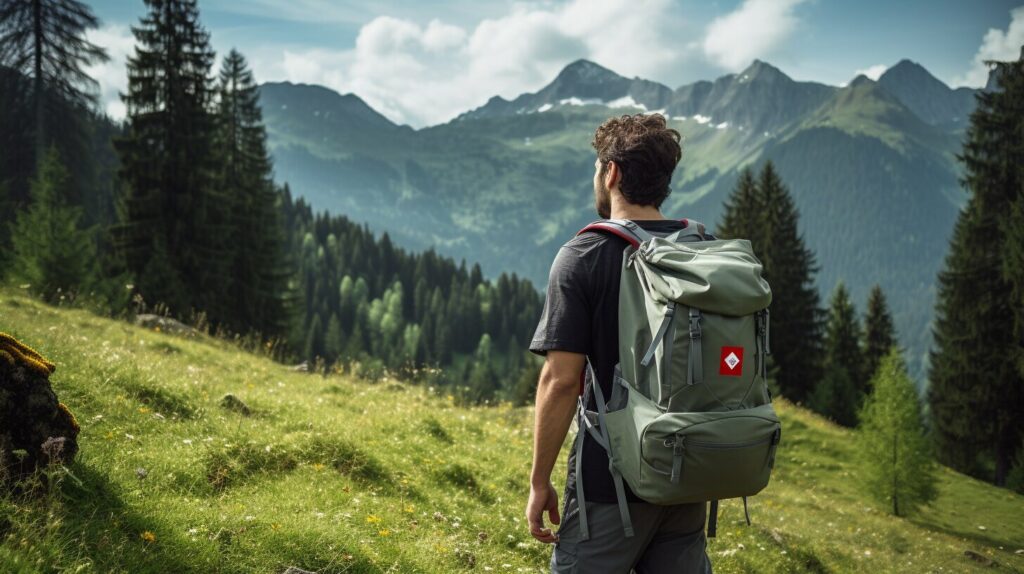
Next up, we’ll explore the basic wilderness medical techniques necessary for addressing injuries and emergencies in the wild.
Basic Wilderness Medical Techniques
When you’re in the wilderness, it’s important to be prepared to handle medical emergencies that may arise. Often, professional medical help may be hours or even days away, so having a basic understanding of wilderness medical techniques is essential.
The first step is to assess the situation and determine the severity of the injury or illness. If the injury is life-threatening, immediate action must be taken. If the injury is not life-threatening, you can take some time to plan and prepare before administering treatment.
One essential technique is to know how to stop bleeding. Direct pressure on a wound is usually the best way to stop bleeding. If direct pressure isn’t enough, try raising the affected limb above the level of the heart. Using a tourniquet should be a last resort.
Another important technique is to know how to stabilize fractures or sprains. In the wilderness, you may not have access to splints, so you need to improvise. A makeshift splint can be fashioned out of sticks, a sleeping pad, or other materials you have on hand.
It’s also important to understand how to treat burns, hypothermia, and dehydration. Knowing how to properly care for these conditions can mean the difference between life and death in the wilderness.
Additional Tips:
- Always carry a first aid kit and know how to use all the items inside.
- Be familiar with the area’s wildlife and know how to identify and treat animal bites.
- Carry a map and compass and know how to navigate to the nearest help if needed.
- Always tell someone where you’re going and when you expect to be back.
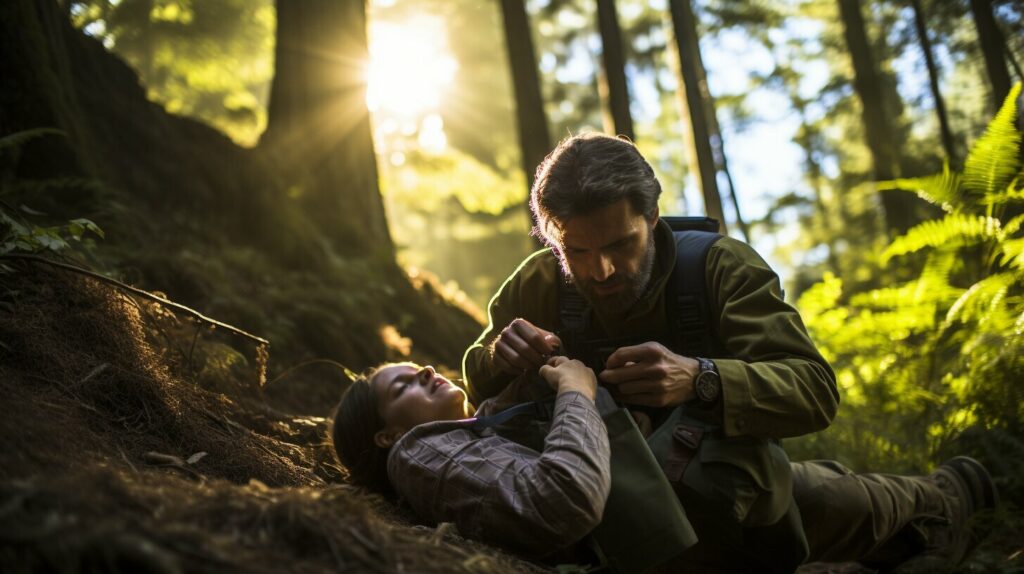
Remember, in the wilderness, you are your first responder. Being prepared and knowledgeable can make all the difference in the event of a medical emergency.
Common Wilderness Injuries and Their Treatment
When venturing into the wilderness, it’s important to be prepared for potential injuries and emergencies. Here are some of the most common wilderness injuries and the first aid techniques to treat them:
Cuts and Scrapes
Cuts and scrapes are common injuries in the wilderness. To treat these injuries, clean the wound with soap and water, apply pressure to stop any bleeding, and cover the wound with a sterile dressing or bandage. If the wound is deep or shows signs of infection, seek professional medical attention.
Burns
If you or someone in your group suffers a burn in the wilderness, remove the source of the burn and cool the affected area with cool water or a cold compress. Cover the burn with a sterile dressing or bandage, and avoid breaking any blisters that may have formed. Seek professional medical attention if the burn is severe or covers a large area of the body.
Fractures and Sprains
If you suspect a fracture or sprain, immobilize the affected area and apply ice or a cold compress to reduce swelling. Seek professional medical attention as soon as possible, particularly if the injury is severe or involves the head, neck, or back.
Hypothermia
Hypothermia occurs when the body loses heat faster than it can produce it, often due to exposure to cold and wet conditions. If you or someone in your group shows signs of hypothermia, including shivering, confusion, and slurred speech, move to a warm and dry location and wrap the person in blankets or warm clothing. Seek professional medical attention as soon as possible.
Remember, when providing wilderness first aid for injuries, it’s important to remain calm, assess the situation, and provide appropriate care. Always seek professional medical attention for severe or life-threatening injuries.
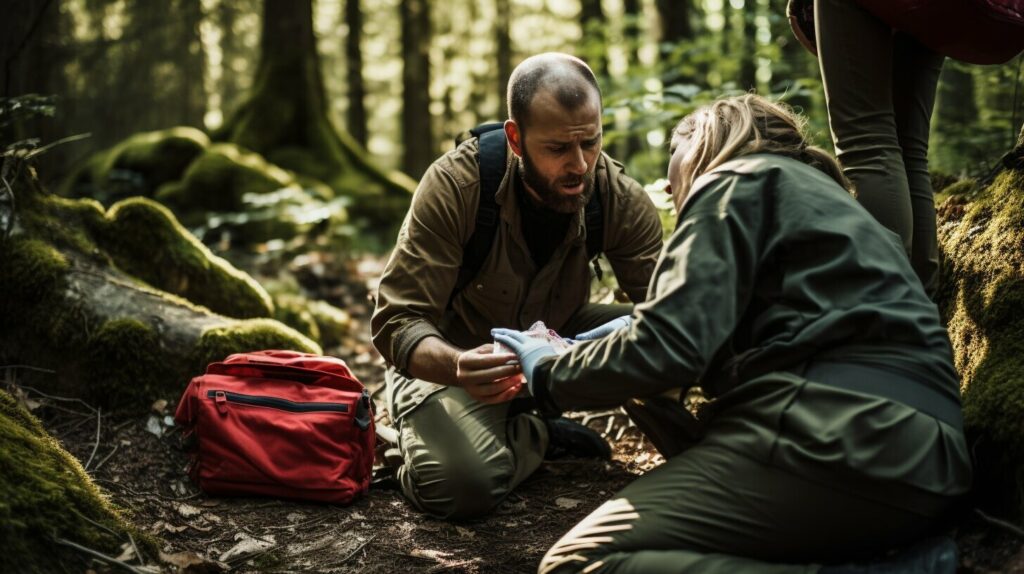
Wilderness First Aid Kit Essentials
When venturing into the wilderness, it is essential to have a well-stocked first aid kit. A properly equipped kit can make all the difference in an emergency situation. Here are the wilderness first aid kit essentials you should consider:
| Item | Use |
|---|---|
| Adhesive bandages | For small cuts and blisters |
| Gauze pads | For larger cuts and scrapes |
| Adhesive tape | To secure dressings and splints |
| Antibacterial ointment | To prevent infection in wounds |
| Tweezers | To remove splinters and ticks |
| Scissors | To cut bandages and clothing |
| Tourniquet | To stop severe bleeding |
| Instant cold packs | To reduce swelling and pain |
| Medications | Prescription and over-the-counter medications for personal use and allergies |
| Emergency blanket | To keep warm in case of hypothermia |
| Whistle | To signal for help |
| Multi-tool | To fix gear and tools |
| First aid manual | To reference first aid techniques and procedures |
Remember to customize your kit to meet your specific needs and the needs of your group. Some additional items to consider include:
- Snakebite kit
- Waterproof matches
- Hand sanitizer
- Sunscreen
- Insect repellent
- Emergency shelter (such as a tarp or bivy sack)
It’s essential to keep your kit in a waterproof container and check its contents before each trip. Make sure everyone in your group knows the location of the first aid kit and how to use its contents properly.
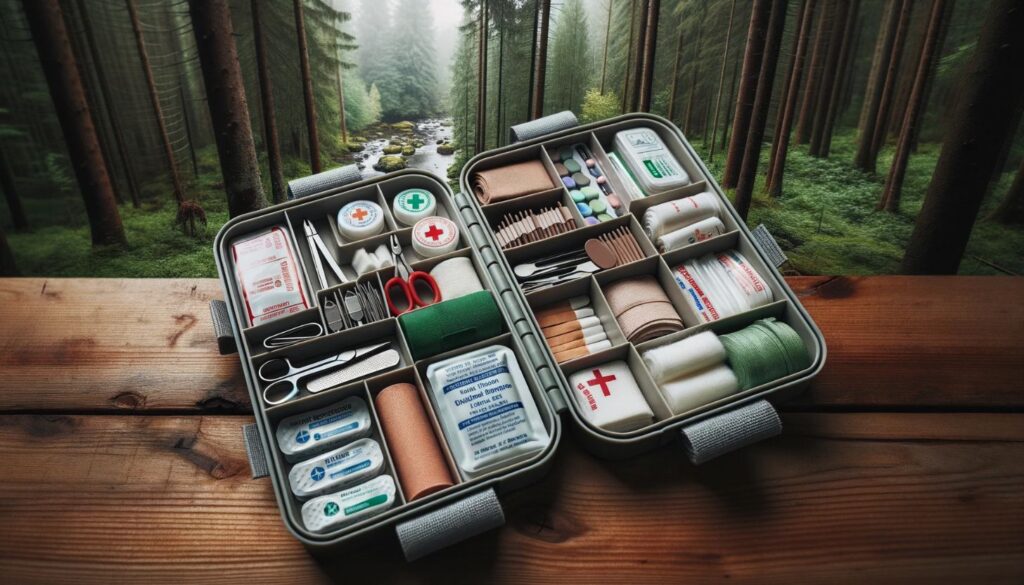
Wilderness First Aid for Environmental Hazards
When you’re exploring the wilderness, you may be exposed to a range of environmental hazards that can potentially lead to injury or illness. It’s important to be prepared for these hazards and know how to identify and respond to them to ensure your safety and that of others you may be with.
One common environmental hazard in the wilderness is heatstroke, which can occur when your body temperature rises to dangerous levels due to prolonged exposure to high temperatures. Symptoms of heatstroke include a high body temperature, confusion, and loss of consciousness. To prevent heatstroke, it’s important to stay hydrated, wear appropriate clothing, and take frequent breaks in shady areas.
Dehydration is another common environmental hazard in the wilderness. It occurs when your body loses more water than it takes in, leading to symptoms such as dry mouth, headache, and fatigue. To prevent dehydration, make sure you drink plenty of water and avoid drinks that dehydrate you, such as alcohol and caffeine.
If you encounter a wild animal while in the wilderness, it’s important to know how to react to avoid injury. Some common animal encounters include snake bites and encounters with bears or other large animals. If you see a snake, move away slowly and avoid provoking it. If you encounter a bear, try to back away slowly without turning your back on the animal.
Remember, prevention is key when it comes to avoiding environmental hazards in the wilderness. By staying hydrated, wearing appropriate clothing, and avoiding potentially dangerous animals, you can reduce your risk of injury or illness. However, if you do encounter an environmental hazard and need medical attention, make sure you know how to administer proper wilderness first aid for injuries and seek professional medical care as soon as possible.
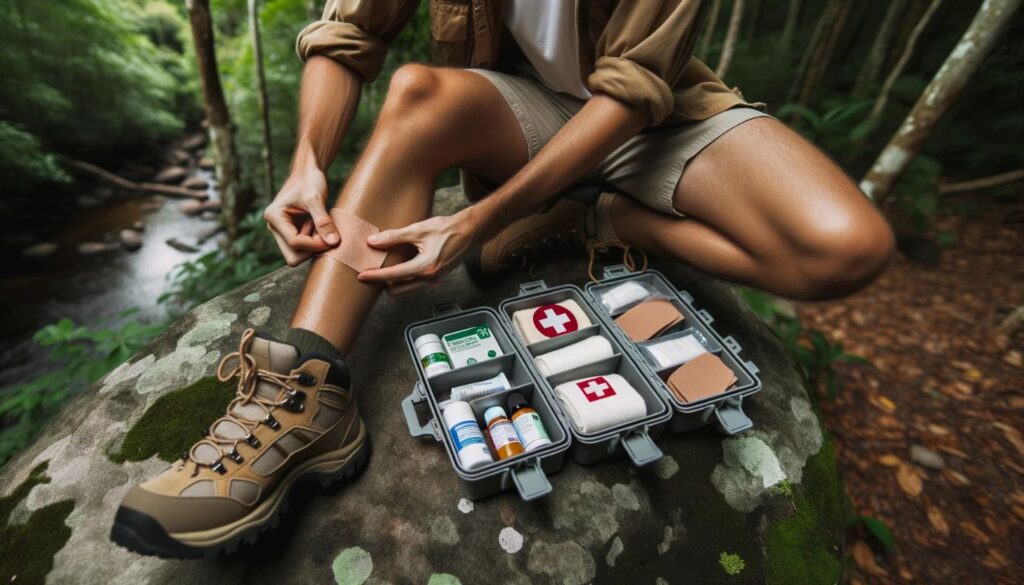
Remote Communication and Evacuation in Wilderness Emergencies
When a medical emergency occurs in the wilderness, communication and evacuation become critical. Your ability to seek help and arrange for medical evacuation can mean the difference between life and death.
The first step is to assess the situation and determine the severity of the injury. If the injury is severe or life-threatening, immediate medical evacuation is necessary. In such cases, use your emergency communication device to request evacuation as soon as possible. If you do not have an emergency communication device, you can try to signal for help by using a whistle, mirror, or other signaling device.
When calling for help, provide as much information as possible about your location and the nature of the injury. This information will help the rescue team in its efforts to locate and transport you and your injured companion(s) as quickly and safely as possible.
If evacuation is not possible due to inclement weather or other factors, you must treat the injured person(s) and stay with them until evacuation is feasible. Ensure that the injured person(s) are kept warm and comfortable, and be prepared to provide ongoing care and support until help arrives.
Remember that communication and evacuation in wilderness emergencies require careful planning and preparation. Ensure that you have the necessary equipment and training to respond effectively in emergency situations. By being prepared and staying vigilant, you can minimize risk and stay safe in the great outdoors.
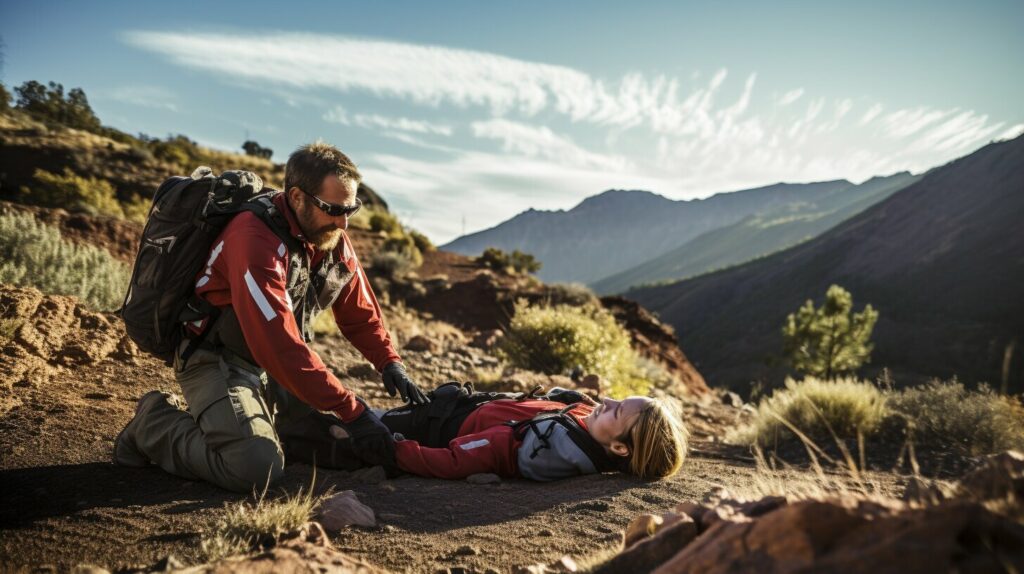
Conclusion
By taking the time to learn wilderness first aid for injuries, you can confidently handle emergencies and ensure your safety in remote environments. Remember to always carry a well-stocked wilderness first aid kit and familiarize yourself with its contents.
Whether you are hiking, camping, or engaging in any outdoor activity, being prepared for emergencies is vital. With wilderness first aid training and certification, you can acquire the necessary skills and knowledge to respond effectively to injuries and medical emergencies.
Remember to stay alert for environmental hazards and know how to identify and treat them. In the event of a serious injury, always seek remote communication and evacuation services. Your safety and well-being are paramount.
So go ahead, plan your next outdoor adventure with the confidence that comes from knowing you are equipped to handle any situation that may arise. Stay safe, have fun, and enjoy the great outdoors!
FAQ
What is wilderness first aid for injuries?
Wilderness first aid for injuries is a specialized form of medical care that focuses on providing emergency aid in remote outdoor environments. It involves learning and using medical techniques and skills to treat injuries and emergencies when professional medical help may not be readily available.
Why is wilderness first aid training important?
Wilderness first aid training is essential because it equips individuals with the knowledge and skills needed to handle medical emergencies in the wilderness. It teaches techniques for assessing and stabilizing patients, addressing common injuries, and understanding environmental hazards to ensure the safety and well-being of oneself and others.
What certification is required for wilderness first responder?
The wilderness first responder certification is an advanced level of training. It requires completing a comprehensive course that covers a wide range of medical skills and knowledge specific to wilderness environments. This certification is often sought by outdoor professionals and those who spend extended periods in remote areas.
What are some basic wilderness medical techniques?
Basic wilderness medical techniques include assessing a patient’s condition, controlling bleeding, splinting fractures, treating burns, managing hypothermia or heatstroke, and performing CPR if necessary. These techniques aim to provide immediate care and stabilize the patient until professional medical help is available.
How can I treat common wilderness injuries?
The treatment for common wilderness injuries varies depending on the injury type. For cuts and burns, clean the wound and cover it with a sterile dressing. For fractures, immobilize the injured area with a splint. For hypothermia, rewarm the person gradually. It’s important to always seek professional medical help as soon as possible.
What should be included in a wilderness first aid kit?
A wilderness first aid kit should include items like bandages, adhesive tape, antiseptic wipes, gauze pads, a CPR mask, splints, pain relievers, insect repellent, and a small emergency blanket. It’s essential to customize your kit based on the activities you’ll be undertaking and the potential injuries you may encounter.
How can I handle environmental hazards in wilderness emergencies?
To handle environmental hazards in wilderness emergencies, you should learn to recognize the signs and symptoms of heatstroke, dehydration, and animal bites. Take appropriate measures like seeking shade and hydration, applying cool compresses, and cleaning and dressing animal bites promptly. It’s crucial to monitor the patient’s condition and seek immediate medical assistance if necessary.
What should I do in case of a wilderness emergency requiring evacuation?
In case of a wilderness emergency requiring evacuation, it’s important to have a communication plan. Use available means to call for help or send a distress signal. If possible, provide clear information about your location and the nature of the emergency. Stay calm and follow any instructions given by emergency responders.




